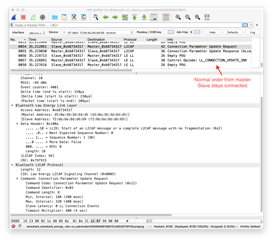Our peripheral application sends an L2CAP Connection Parameters Update Request to change the connection interval 30 seconds after connecting. For most hosts, it works fine. But with an Android 6 tablet it disconnects right after the switch to the new connection interval. Wireshark shows the following packet sequence.
- Slave sends L2CAP Connection Parameters Update Request
- Master sends L2CAP Connection Parameters Update Request (Accepted)
- Slave sends empty PDU in response
- Master sends LL_CONNECTION_UPDATE_IND with details of the new parameters and when to switch
- At the proper time, the two sides change to the new connection interval and everything is fine
But with the Android 6 tablet, the order of the Master's packets is reversed, and the slave (our device) disconnects right after the interval switch:
- Slave sends L2CAP Connection Parameters Update Request
- Master sends LL_CONNECTION_UPDATE_IND with details of the new parameters and when to switch
- Slave sends empty PDU in response
- Master sends L2CAP Connection Parameters Update Request (Accepted)
- At the proper time, the two sides change to the new connection interval for just the first interval
- After that the slave immediately disconnects, stops responding and starts advertising again
- The host eventually gives up due to the lack of responses and also disconnects
We are using an nRF52833 with S113 SoftDevice, and version 17.0.2 of the SDK. We get the same results when we change the requested range of the connection interval (e.g.- 100-200 msecs, 200-400, 20-200...) and the Android system always picks an interval within the requested range, so that doesn't seem to be the problem.
Does the order of the master's response matter? The order that works matches what you show in your Peripheral Connection Parameter Update message sequence chart (https://infocenter.nordicsemi.com/topic/com.nordic.infocenter.s113.api.v7.2.0/group___b_l_e___g_a_p___c_p_u___m_s_c.html). Does the BLE stack get confused and disconnect if the LL_CONNECTION_UPDATE_IND comes before the L2CAP acceptance of the request?
We don't seem to have this problem with later versions of Android (such as 9.x), but I don't have one here to try with Wireshark to see if its order is different.
Normal order works:

Reverse order from master. Slave disconnects right after switching connection interval time.



